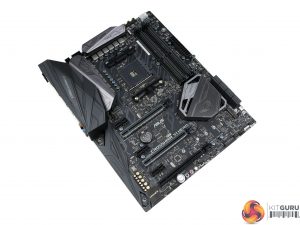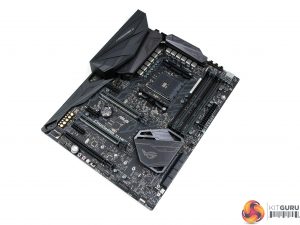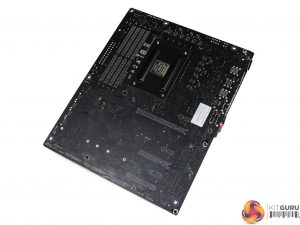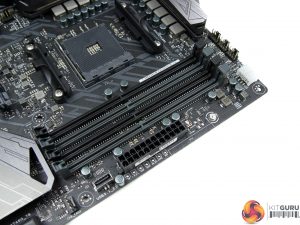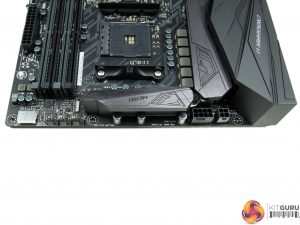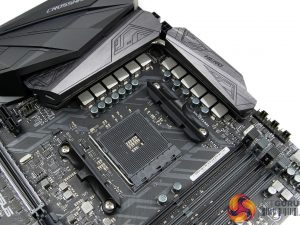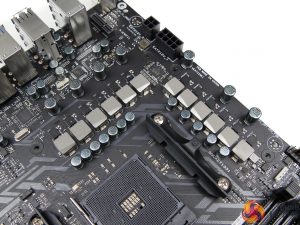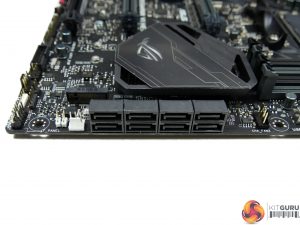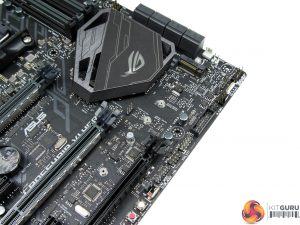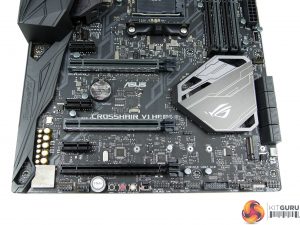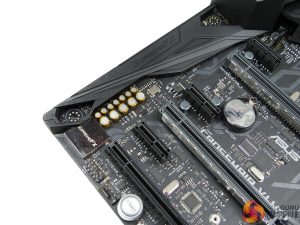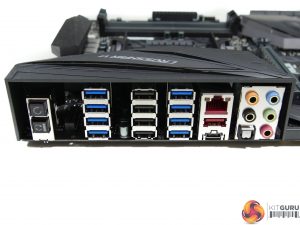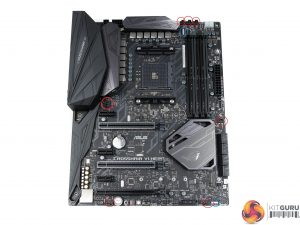The ASUS ROG Crosshair VI Hero is formed with a dark black and grey colour scheme which is very neutral. I like this decision with some of ASUS' recent ROG motherboards as it allows the hardware to better match other components that the bright red of old does not. Onboard RGB LEDs allow the motherboard to add sprinkles of colour in certain areas.
Large heatsinks and onboard buttons show glimpses of the Hero's ROG and overclocking-focused intention. Those sizeable heatsinks will be put to good use by the eight-core Ryzen 7 chips that demand a sizeable amount of power when overclocked.
Strengthened PCIe x16 slots and a rear IO cover are noticeable on the Hero. The strengthened slots help to reduce the possibility of GPU sag or a slot breaking during shipping. The rear IO cover is purely aesthetic and features an RGB LED which allows the Crosshair branding to be lit up.
Only two lighting zones are present on the Hero – the rear IO cover and the chipset heatsink. Two RGB strip headers can be used to add further lighting through the use of an external kit.
Up to 64GB of DDR4 memory can installed in the single-latch DIMM slots. ASUS quotes support for 3200MHz memory via overclocking but this is currently only possible with certain memory kits due to the infancy of the AM4 platform. We used a 3200MHz G.SKILL Trident Z kit successfully. Faster memory speeds may be possible via overclocking (we have seen reports of 3600MHz) but this involves manual adjustments to the BCLK.
Close to the 24-pin connector are onboard voltage reading points that may prove useful to overclockers or troubleshooting users. Just to the left of those is an internal 10Gbps USB 3.1 Gen 2 header that receives its bandwidth from the X370 chipset. I am yet to see this interface deployed on a chassis but it should be the standard going forward. Kudos to ASUS for supporting it rather than deploying those USB 3.1 connections on the rear panel.
A supplementary 4-pin power connector joins the conventional 8-pin port. This allows additional current to be fed to hungry Ryzen 7 CPUs without overloading a single power connector. That's unlikely to be an issue for users who aren't doing hardcore overclocking but if your PSU has dual CPU connectors, there's no harm in deploying both. The 2-digit debug LED sits next to a bank of 4-pin fan headers assigned for CPU and AIO pump duties, as well as one of the 4-pin RGB headers.
A notable unique point for ASUS is the inclusion of AM3 mounting holes in addition to those assigned AM4 duties. This is convenient for users with a CPU cooler or waterblock that has not been updated with AM4 mounting brackets, or if you bought your cooler second hand and are not eligible to receive the necessary AM4 hardware.
A total of twelve power delivery phases are split between CPU (eight) and SOC (four) voltage duties. ASUS uses a Digi+ EPU ASP1405I PWM controller to manage the twelve 40A Texas Instruments 87350D NexFET power blocks (MOSFETs), twelve rear-mounted International Rectifiers IR3535M drivers, and six IR3599 PWM phase doublers. The R40-marked chokes use a MicroFine alloy construction, according to ASUS, and the capacitors are 10K-rated.
Memory is a two-phase design managed by a Digi+ ASP1103 controller.
All eight of the right-angled SATA 6Gbps ports are provided by the X370 ‘Promontory' chipset. Every one of the ports can be used at any one time.
There is no U.2 port, which is slightly disappointing given the AM4 platform's potential for prosumer use with Ryzen 7 CPUs. ASUS' omission of SATA-Express makes perfect sense, especially with the onboard USB 3.1 header being provided.
A single 32Gbps PCIe 3.0 x4 NVMe-capable M.2 slot can house drives up to 110mm in length and it can also handle SATA-based M.2 SSDs. The port is given its bandwidth with a direct PCIe 3.0 x4 (or SATA) link to the Ryzen CPU.
The mounting location is both good and bad. It's good because the M.2 SSD is away from a graphics card and is likely to receive less hot exhaust air from one. It is also good because the location means that single-GPU users could install an M.2-to-U.2 adapter and use it without interference. However, the location of the slot means that an ugly green M.2 SSD PCB will be visible for all to see.
I would like to see ASUS give more consideration to M.2 SSD cooling. Thermal throttling under sustained write workloads is a real issue for many fast M.2 PCIe NVMe SSDs. It would be very easy to branch a heatsink off from the chipset cover and would provide additional cooling capacity for an M.2 device.
ASUS provides a 3D printing mount near the M.2 connector with the intention of an end-user printing a fan bracket to cool the SSD. This is not, however, a realistic scenario for most purchasers so a bracket can be purchased for £8-11 from Shapeways. It would be preferable for ASUS to make a batch order to drive down the per-unit price and include the fan bracket by default.
The two primary full-length PCIe slots are given ASUS' SafeSlot treatment that makes them thicker and stronger. These are the two connectors that get their PCIe 3.0 lanes from the CPU and will run at x16/x0 or x8/x8 for CrossFire and SLI. Spacing between them is ideal for 2- or 2.5-slot cards to be given a cooling gap.
Four lanes of PCIe 2.0 bandwidth from the X370 chipset are fed to the lower full-length PCIe slot. This bandwidth is shared with the trio of open-ended PCIe 2.0 x1 slots.
Clearly, high-speed PCIe connectivity is limited on AMD's AM4 platform. If you want to use two graphics cards in SLI alongside a PCIe 3.0 x4 M.2 SSD, there's no more bandwidth for another PCIe Gen 3 SSD.
The usual combination of ports and headers is found along the board's bottom edge. ASUS also provides onboard buttons, sensor points for liquid cooling users, and a 5Gbps USB 3.0 header to partner the internal USB 3.1 connector.
The ROG SupremeFX audio system uses a ‘S1220' codec, Nichicon audio capacitors, an ESS ES9023P DAC, and shielding for the components. Software-based audio features such as Sonic Radar III and Sonic Studio III are supported.
USB ports steal the rear IO show. A total of eight 5Gbps USB 3.0 Type-A ports are delivered from both the Ryzen CPU and the X370 chipset (four from each). Four more USB Type-A ports, this time at 2.0 speeds, are provided by the X370 chipset. I like to see these included for devices that do not need faster links, such as peripherals. The two 10Gbps USB 3.1 Gen 2 ports (Type-C provided by the ASMedia ASM1543 logic) are provided by a PCIe 2.0 x2 ASMedia ASM1143 chipset which is inferior to the ASM2142 revision found on many Z270 motherboards.
Gigabit Ethernet is provided by an Intel I211AT NIC, aided by an ASUS LANGuard component. The standard affair of audio ports join BIOS Flashback and reset (effectively clear CMOS) buttons, which prove useful with the platform in its infancy and still experiencing bugs. No onboard video ports is not a problem in my opinion as it is highly unlikely that this motherboard will be partnered with a future Zen-based APU.
Seven 4-pin fan headers are smartly distributed around the motherboard. The headers support PWM and DC control using the UEFI and OS software. Two 4-pin RGB headers are mounted on opposite sides of the motherboard to aid usability with RGB strips in large cases.
An ITE IT8665E chipset manages monitoring and fan control duties.
Be sure to check out our sponsors store EKWB here
 KitGuru KitGuru.net – Tech News | Hardware News | Hardware Reviews | IOS | Mobile | Gaming | Graphics Cards
KitGuru KitGuru.net – Tech News | Hardware News | Hardware Reviews | IOS | Mobile | Gaming | Graphics Cards


